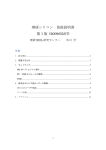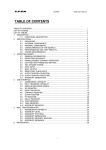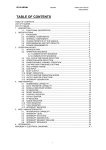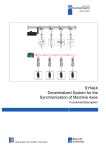Download downloading
Transcript
Technical
Information
Manual
Revision n. 2
9 June 2000
MOD. V 550 - V 550A
2 CHANNEL
C-RAMS
9/06/2000
V550-V550A User's Manual
WARNING
Before inserting the module in a V430 Crate, if the -5 V
from Jaux option is selected via internal jumpers, please
verify the existence of the -5 V supply on the crate itself. If
this is missing, the V550 will not operate correctly and
might show a non-reversible failure in the ADC.
9/06/2000
V550-V550A User's Manual
TABLE OF CONTENTS
TABLE OF CONTENTS .....................................................................................................................i
LIST OF FIGURES..............................................................................................................................ii
LIST OF TABLES ...............................................................................................................................ii
1.DESCRIPTION.................................................................................................................................1
1.1. FUNCTIONAL DESCRIPTION ..........................................................................1
2.SPECIFICATIONS ...........................................................................................................................3
2.1. INPUTS.............................................................................................................3
2.2. OUTPUTS.........................................................................................................3
2.3. PERFORMANCES AND TEST RESULTS.........................................................3
2.4. POWER REQUIREMENTS ...............................................................................3
2.5. INTERNAL COMPONENTS AND SETTINGS....................................................5
3.VME INTERFACE ...........................................................................................................................8
3.1. ADDRESSING CAPABILITY .............................................................................8
3.2. DATA TRANSFER CAPABILITY .......................................................................8
3.3. MODULE IDENTIFIER WORDS........................................................................9
3.4. TEST PATTERN REGISTERS ..........................................................................10
3.5. WORD COUNTER REGISTERS .......................................................................10
3.6. FIFO CHANNEL 0 AND 1..................................................................................10
3.7. CLEAR MODULE..............................................................................................11
3.8. NUMBER OF CHANNELS.................................................................................11
3.9. STATUS REGISTER.........................................................................................12
3.10. INTERRUPT REGISTER...................................................................................13
3.11. PEDESTAL AND THRESHOLD MEMORIES.....................................................13
4.OPERATING MODES......................................................................................................................14
4.1. GENERAL INFORMATION ...............................................................................14
4.2. CONNECTION SCHEMES................................................................................14
4.2.1. USING MOD. V550 AND V551B WITH JAUX DATAWAY ..................15
4.2.2. USING MOD. V550 AND V551B WITHOUT JAUX DATAWAY...........15
4.3. OPERATION SEQUENCE ................................................................................17
4.4. THRESHOLDS AND PEDESTALS....................................................................18
4.5. DIAGNOSTICS AND TEST ...............................................................................18
4.6. INTERRUPT GENERATION..............................................................................19
REFERENCES ....................................................................................................................................20
i
9/06/2000
V550-V550A User's Manual
LIST OF FIGURES
Fig. 1.1: Block Diagram .......................................................................................................................2
Fig. 2.1: Front Panel.............................................................................................................................4
Fig. 2.2: Components Locations (component side) ................................................................................6
Fig. 2.3: Components Locations (soldering side)...................................................................................7
Fig. 3.2: Module Identifier Words.........................................................................................................9
Fig. 3.3: Test pattern Register...............................................................................................................10
Fig. 3.4: Control Register .....................................................................................................................10
Fig. 3.6: Number of channels................................................................................................................11
Fig. 3.7: Status Register........................................................................................................................12
Fig. 3.8: Interrupt Register....................................................................................................................13
Fig. 3.9: Pedestal/Threshold memories..................................................................................................13
Fig. 4.1: System Layout with connections via Auxiliary VME bus ........................................................16
ii
9/06/2000
V550-V550A User's Manual
LIST OF TABLES
Table 3.1: Address Map .......................................................................................................................9
iii
9/06/2000
1.
V550-V550A User's Manual
DESCRIPTION
1.1.
FUNCTIONAL DESCRIPTION
The model V550 CAEN Readout for Analog Multiplexed Signals (C-RAMS) is a 1-unit
wide VME module housing 2 independent Analog to Digital Conversion blocks to be
used for the readout of analog multiplexed signals coming from some of well known
front-end chips (Amplex, Gasplex, Viking, etc.).
Each block of the module accepts positive, negative or differential input signals; the
signals are amplified and fed to an ADC. The sensitivity (mV/bit) can be selected among
4 different values (with relative ratios of 1, 2, 5 and 10) by means of internal jumpers.
The module has the following features:
•
•
•
•
•
conversion rate up to 5 MHz.
differential input with selectable amplification.
10 bit (V 550) / 12 bit (V 550 A) linear conversion.
zero suppression and pedestal subtraction.
diagnostics and self-test capabilities.
With the occurrence of an external CONVERT signal, the input signal is sampled by the
ADC and its digital value is compared to a threshold value, if the signal is over threshold,
the pedestal is subtracted and the result is stored in a Output Buffer arranged in FIFO
logic 2K x 32 bit. For this purpose each block of the module houses two memories for
the storage of the thresholds and the pedestals of each detector channel. The pedestal
and threshold values are independent for each channel and the pedestal/threshold
memory, which is arranged in 2K x 24 bit, can be filled (and read back) via VME with the
desired values.
The number N of detector channels to be read out can be programmed via VME
between 32 and 2016 in steps of 32. At the end of a conversion cycle (N CONVERT
pulses), with the last word stored in the FIFO, if there are data in the FIFO, the module
channel goes in the Data Ready state signaling that the data must be read via VME. A
positive open-collector signal ("DRDY") is available for each channel on the front panel
and is provided with two bridged connectors for daisy chaining. A fast CLEAR signal is
also available for cycle abort.
It is possible to operate the module also in TEST mode (VME selectable) by simulating
some input patterns, which can be written via VME, as if they were coming from the
ADC.
The module houses a VME RORA INTERRUPTER[1]: via VME it is possible to program
the interrupt generation on the logical OR of the two DRDY signals in a board.
The V550 Model uses the P1 and P2 connectors of VME and, optionally, the auxiliary
connector for the CERN V430 VMEbus crate (Jaux Dataway) [1, 2]. With the Jaux
connector it is possible to send via backplane the CONVERT, CLEAR and DRDY
signals.
The module works in A24/A32 mode. The data transfer occurs in D32 mode. Block
Transfer mode is also available.
Page 1 of 20
9/06/2000
V550-V550A User's Manual
The V550 Model can be controlled by the CAEN Model V551B C-RAMS SEQUENCER.
A single V551B Module can control up to 19 C-RAMS modules in a complete VME crate.
Page 2 of 20
9/06/2000
V550-V550A User's Manual
TEST PATTERN
VME
BUS
PED. & TH.
MEMORY
ZERO
IN0+
IN0-
MUX
+
FIFO
SUPPRESSION
ADC
_
Test Mode
Ch
CONTROL LOGIC
Nr.
CONV
IDENTIFIER
DRDY0
VME
INTERFACE
CLEAR
IRQ
INTERRUPTER
DRDY1
INT. LEVEL
STATUS /ID
CONV
Ch
CONTROL LOGIC
Nr.
Test Mode
IN1+
+
IN1-
_
ADC
ZERO
MUX
SUPPRESSION
PED. & TH.
MEMORY
VME
BUS
TEST PATTERN
Fig. 1.1: Block Diagram
Page 3 of 20
FIFO
9/06/2000
2.
V550-V550A User's Manual
SPECIFICATIONS
2.1.
INPUTS
- INPUT CHANNELS: Positive, negative or differential inputs on
LEMO 00 type connectors; 50 Ω impedance;
Input ranges: 150 mV, 300 mV, 750 mV and 1.5 V.
- CONVERT(1):
Std. NIM level, high impedance, on two LEMO 00 type
bridged connectors (for daisy chaining); requires termination
if not chained, see note (1) here below.
ECL differential on Jaux connector.
Min. width 100 ns; Maximum sampling frequency: 5 MHz.
A green LED lights up during a convert cycle or
a Test Pattern injection.
- CLEAR(1):
Std. NIM level, high impedance, on two LEMO 00 type
bridged connectors (for daisy chaining); requires termination
if not chained, see note (1) here below.
ECL differential on Jaux connector.
Min. width 50 ns.
2.2.
OUTPUTS
- DATA READY:
Std. TTL Open Collector on two LEMO 00 type
bridged connectors (for daisy chaining);
active high (the same on Jaux).
A green LED lights up when the DRDY signal is asserted.
(1) High impedance input provided with two bridged connectors for daisy chaining. Note that the chain
has to be terminated on 50 Ω on the last module; the same is needed also if only one module is used,
whose input has thus to be properly matched.
2.3.
PERFORMANCES AND TEST RESULTS
Integral Non Linearity:
DC Pedestal:
± 0.1%
10 ± 2 counts ( V 550 for all input ranges).
40 ± 8 counts ( V 550A for all input ranges).
N.B.: The "DC Pedestal" is the digital value stored in the FIFOs when there is no input
signal and the threshold is set to zero (Zero Suppression is disabled).
Page 4 of 20
9/06/2000
2.4.
+ 12 V
− 12 V
+5V
−5V
POWER REQUIREMENTS
100 mA
200 mA (100 mA if Jaux is used)
2.5 A
100 mA (only if Jaux is used)
Page 5 of 20
V550-V550A User's Manual
9/06/2000
V550-V550A User's Manual
Mod. V560E
Mod. V550
VME selected LED
DTACK
CH0
+
DIFFERENTIAL ANALOG input
I
N
CONVERT input
C
O
N
V
DATA READY output
D
R
D
Y
_
CH1
+
I
N
_
C
O
N
V
D
R
D
Y
CLEAR input
C
L
E
A
R
16 CH
SCALER
C - RAMS
Fig. 2.1: Front Panel
Page 6 of 20
9/06/2000
2.5.
V550-V550A User's Manual
INTERNAL COMPONENTS AND SETTINGS
(refer to fig. 2.2, 2.3)
SWITCHES, JUMPERS
- "JP1..JP8" jumpers; for the channel 0 sensitivity selection.
- "JP9..JP16" jumpers; for the channel 1 sensitivity selection:
for each channel, four different Full Scale Voltage Ranges are available by setting
simultaneously JP1..JP4 for channel 0 Pedestal adjust, and JP5..JP8 for channel 0 Gain
adjust (JP9..JP12 and JP13..JP16 respectively for channel 1). The four different levels of
sensitivity are indicated with the numbers 1, 2, 3 and 4 which are printed close to the
jumpers on the soldering side of the board, and correspond to the following full scale
voltage ranges (e.g. for Channel 0):
Number 1
Number 2
Number 3
Number 4
→
→
→
→
150 mV
300 mV
750 mV
1.5 V
(JP4 and JP8 inserted)
(JP3 and JP7 inserted)
(JP2 and JP6 inserted)
(JP1 and JP5 inserted)
- "JP17" jumper; for the -5 V power selection:
by setting the jumper named JP17 is possible to choose the -5 V power supply coming
from the -12 V VME (VEE position) power supply or directly from the -5 V Jaux (AUX
position) power supply. Like the sensitivity selection jumpers JP1..JP16, this jumper is
placed in the soldering side of the board.
- "S1", 2 DIP switches to enable/disable the CONV detection via the Jaux backplane
signals CK and CK*.
- "S2", 2 DIP switches to enable/disable the CLEAR detection via the Jaux backplane
signals CL and CL*.
- "S3" DIP switch to enable/disable the DRDY generation on the Jaux backplane signal
SG.
By setting the three DIP switches S1, S2 and S3 in the OFF position, is possible to
disable the CONV, CLEAR and DRDY signals handling via Jaux backplane. In this case
the CK, CK*, CL, CL* and SG Jaux lines are disconnected.
- 1, socket strip housing a removable package resistor for the CK, CK*, CL, CL* Jaux
lines termination (the resistor's common pin is shown in fig. 2.3). An alternative
electrically isolated socket strip has been provided with the component side of the board:
the removable package termination may be plugged here in case it is not used.
- 4 rotary switches for the module's VME Base Address selection.
Page 7 of 20
9/06/2000
V550-V550A User's Manual
Base address bit <23..20>
Rotary switches
for Base Address selection
Base address bit <19..16>
JP5 JP6 JP7 JP8
JP1 JP2
JP3 JP4
VME P1 connector
Electrically isolated case
for the removable 50 Ohm
package termination
JP13 JP14 JP15 JP16
JP9 JP10
CONV
S1
CLEAR
S2
DRDY
S3
JP11 JP12
Removable 50 Ohm
package termination for
auxiliary VME bus lines
Resistor's common pin
VEE
Paux connector
for CERN VMEbus
crate type V430
AUX
JP17
VME P2 connector
Component side of the board
Base address bit <31..28>
Rotary switches
for Base Address selection
Base address bit <27..24>
Fig. 2.2: Components Locations (component side)
Page 8 of 20
9/06/2000
V550-V550A User's Manual
(JP8)
(JP6)
1 2
3 4
(JP7)
(JP2)
3 4
(JP4)
1 2
(JP5)
(JP3)
(JP1)
Channel 0 sensivity selection
(JP16)
(JP14)
1 2
3 4
(JP15)
(JP12)
1 2
(JP10)
3 4
(JP13)
(JP11)
-5V power supply selection
(JP17)
AUX
VEE
Channel 1 sensivity selection
Soldering side of the board
Fig. 2.3: Components Locations (soldering side)
Page 9 of 20
(JP9)
9/06/2000
3.
V550-V550A User's Manual
VME INTERFACE
3.1.
ADDRESSING CAPABILITY
The module works in A24/A32 mode. This implies that the module's address must be
specified in a field of 24 or 32 bits. The Address Modifiers code recognized by the
module are:
AM = %3F
AM = %3D
AM = %3B
AM = %39
AM = %0F
AM = %0D
AM = %0B
AM = %09
A24 supervisory block transfer (BLT);
A24 supervisory data access;
A24 non privileged block transfer (BLT);
A24 non privileged data access;
A32 supervisory block transfer (BLT);
A32 supervisory data access;
A32 non privileged block transfer (BLT);
A32 non privileged data access;
The module's Base Address is fixed by 4 internal rotary switches housed on two piggyback boards plugged into the main printed circuit board (see Fig. 2.2).
The Base Address can be selected in the range:
% 00 0000
<->
% 0000 0000 <->
% FF 0000
A24 mode
% FFFF 0000
A32 mode
The Address Map of the page is shown in Table 3.1.
3.2.
DATA TRANSFER CAPABILITY
The internal registers are accessible in D16 mode, while the FIFO and the
Pedestal/Threshold memory are only accessible in D32 mode.
Page 10 of 20
9/06/2000
ADDRESS
V550-V550A User's Manual
REGISTER/CONTENT
TYPE
Base + %5FFC
•
•
•
Base + %4000
Pedestal/Threshold memory channel 1
•
•
•
Pedestal/Threshold memory channel 1
read/write
Base + %3FFC
•
•
•
Base + %2000
Pedestal/Threshold memory channel 0
•
•
•
Pedestal/Threshold memory channel 0
read/write
Base + %FE
Base + %FC
Base + %FA
Version & Series
Manufacturer & module type
Fixed code
read only
read only
read only
Base + %16
Base + %14
Base + %12
Base + %10
Base + %0C
Base + %08
Base + %06
Base + %04
Base + %02
Base + %00
Test pattern channel 1
Test pattern channel 0
Word count channel 1
Word count channel 0
FIFO channel 1
FIFO channel 0
Module clear
Number of channels
Status Register
Interrupt Register
write only
write only
read only
read only
read only
read only
write only
read/write
read/write
write only
Table 3.1: Address Map
3.3.
MODULE IDENTIFIER WORDS
(Base address + %FA, + %FC, + %FE, read only)
Three words located at the address Base + %FA,+ %FC, + %FE of the page are used to
identify the module, as shown in figure 3.2:
15 14 13 12 11 10 9
V e r s i o n
M o d u l e ' s
Manufacturer number
% F A
F i x e d
8
c o d e
7
6
s e r i a l
5
4
3
2
1
n u m b e r
M o d u l e
t y p e
% F 5
F i x e d
0
Address
Base + % FE
Base + % FC
c o d e
Base + % FA
Fig. 3.2: Module Identifier Words
At the address Base + %FA the two particular bytes allow the automatic localization of
the module.
For the Mod. V550 the word at address Base + %FC has the following configuration:
Manufacturer N°=
Type of module=
000010 b
00000110100 b
The word located at the address Base + %FE identifies the single module via a serial
number, and any change in the hardware (for example the use of faster Conversion
Logic) will be shown by the Version number.
Page 11 of 20
9/06/2000
3.4.
V550-V550A User's Manual
TEST PATTERN REGISTERS
(Base address + %16, write only channel 1)
(Base address + %14, write only channel 0)
The Test Pattern registers have the following structure:
15 14 13 12 11 10 9
OV
V
8
7
6
5
4
3
2
1
0
CHANNEL DATA
12 bit detector Channel data
simulated valid data
simulated overrange
Fig. 3.3: Test Pattern Register
3.5.
WORD COUNTER REGISTERS
(Base address + %12, read only channel 1)
(Base address + %10, read only channel 0)
The Word counter registers have the following structure:
15 14 13 12 11 10 9
8
7
6
5
4
3
2
1
0
NUMBER OF OVER THRESHOLD DATA (No. of Data in FIFO)
Fig. 3.4: Word Counter Register
3.6.
FIFO CHANNEL 0 AND 1
(Base address + %0C, read only channel 1)
(Base address + %08, read only channel 0)
The FIFO data have the following structure:
31 30 29 28 27 26 25 24 23 22 21 20 19 18 17 16 15 14 13 12 11 10
O
V
Channel number
Validity bit :
9
8
7
6
5
4
3
2
Channel data
= 0 converted value is under pedestal
= 1 converted value is over pedestal
Overrange bit :
= 0 no FADC overrange
= 1 FADC overrange
Fig. 3.5: FIFO structure
The two FIFOs are also accessible in block transfer mode.
Page 12 of 20
1
0
9/06/2000
3.7.
V550-V550A User's Manual
CLEAR MODULE
(Base address + %06, write only)
A VME write access to this location causes the following:
•
Aborts the conversion process (if active);
•
clears the FIFOs;
•
clears the word counters.
3.8.
NUMBER OF CHANNELS
(Base address + %04, read/write)
This register allows to program the number of detector channels to be read out in step of
32.
This number ranges from 32 (DCN=1) to 2016 (DCN=63), DCN=0 means 1 detector
channel only.
15 14 13 12 11 10 9
8
7
6
5
DCN Channel 1
4
3
2
1
0
DCN Channel 0
Detector Channel Number channel 0
Detector Channel Number channel 1
Fig. 3.6: Number of channels
3.9.
STATUS REGISTER
(Base address + %02, read/write )
Contains information on the status and allows a few settings on the module.
15
14
13
12
11
10
9
8
7
6
5
4
3
2
/F1
/F0
/H1
/H0
/E1
/E0
/D1 /D0
1
0
MO
T
Test mode
Memory Owner
DRDY Channel 0 read only
DRDY Channel 1 read only
FIFO 0 EMPTY read only
FIFO 1 EMPTY read only
FIFO 0 HALF FULL read only
FIFO 1 HALF FULL read only
FIFO 0 FULL read only
FIFO 1 FULL read only
Fig. 3.7: Status Register
Page 13 of 20
9/06/2000
V550-V550A User's Manual
T
Test mode.
=0
no Test mode;
=1
Test mode;
MO
Pedestal Threshold memory owner.
=0
memory owned by VME;
=1
memory owned by the Conversion logic;
/D0
Channel 0 Data Ready bit, read only.
=0
data ready;
/D1
Channel 1 Data Ready bit, read only.
=0
data ready;
/E0
FIFO channel 0 empty bit, read only.
=0
empty;
/E1
FIFO channel 1 empty bit, read only.
=0
empty;
/H0
FIFO CHANNEL 0 half full bit, read only.
=0
half full;
/H1
FIFO CHANNEL 1 half full bit, read only.
=0
half full;
/F0
FIFO CHANNEL 0 full bit, read only.
=0
full;
/F1
FIFO CHANNEL 1 full bit, read only.
=0
full;
3.10.
INTERRUPT REGISTER
(Base address + %0, write only)
This register contains the value of the Interrupt Level and the STATUS/ID that the V550
INTERRUPTER places on the VME data bus during the Interrupt Acknowledge cycle.
15 14 13 12 11 10 9
INT. LEV.
8
7
6
5
4
3
2
1
0
STATUS /I D
Interrupt STATUS/ID
Interrupt level
Fig. 3.8: Interrupt Register
Page 14 of 20
9/06/2000
3.11.
V550-V550A User's Manual
PEDESTAL AND THRESHOLD MEMORIES
(Base address + %2000..5FFE, read/write)
These memories are accessible via VME only if the Memory owner bit is set to 0 (default
mode).
They have the following structure:
CHANNEL 0
Pedestal detector channel 0
Threshold detector channel 0
ADDRESS
Base + % 2000
Pedestal detector channel 1
Threshold detector channel 1
Base + % 2004
Pedestal detector channel 2047
Threshold detector channel 2047
Base + % 3FFC
31 30 29 28 27 26 25 24 23 22 21 20 19 18 17 16 15 14 13 12 11 10 9 8 7 6 5 4 3 2 1 0
CHANNEL 1
Pedestal detector channel 0
Threshold detector channel 0
ADDRESS
Base + % 4000
Pedestal detector channel 1
Threshold detector channel 1
Base + % 4004
Pedestal detector channel 2047
Threshold detector channel 2047
Base + % 5FFC
31 30 29 28 27 26 25 24 23 22 21 20 19 18 17 16 15 14 13 12 11 10 9 8 7 6 5 4 3 2 1 0
Fig. 3.9: Pedestal/Threshold memories
The memories size is 2048 words but only 2016 are actually used by the conversion
logic (2016 is the maximum number of channels).
Page 15 of 20
9/06/2000
4.
V550-V550A User's Manual
OPERATING MODES
4.1.
CONNECTION SCHEMES
(refer to fig. 4.1)
The Model V551B CAEN C-RAMS Sequencer has been designed in order to control
more C-RAMS (CAEN Readout for Analog Multiplexed Signals) Mod. V550 in single
acquisition systems. When a Mod. V551B C-RAMS Sequencer controls more than one
V550 channel, the CONVERT signal is the same for each channel, so that each
multiplexer is controlled by a single CLOCK.
Some connections must be made among the C-RAMS modules and the Sequencer
module to let them work properly: the V551B CONVERT and CLEAR OUT signals must
be distributed towards the C-RAMS acquisition cards and the V550 and V551B DATA
READY signals must be connected together to perform a wired-OR. All this involves the
use of a large number of 50 Ω cables, especially if there are a lot of V550 modules to be
controlled; the Sequencer uses the P1 and P2 VME connectors and optionally the
auxiliary connector for the CERN V430 VMEbus crate (Jaux Dataway), thus, if the VME
auxiliary bus is available, it is possible to send via backplane the CONVERT, CLEAR
OUT and DRDY signals and all these connections can be avoided.
4.1.1. USING MOD. V550 AND V551B WITH JAUX DATAWAY
By means of DIP switches, either on the V550 boards or V551B board, it is possible to
enable the Jaux Dataway (see § 2.3), so that:
1.) The CONVERT signal coming from the V551B module is distributed to the V550
channels.
2.) The CLEAR signal coming from the V551B module is distributed to the V550
channels.
3.) The wired-OR of the V550 DATA READY signals is performed and received by the
V551B.
If on the backplane there is no termination on the CK, CK*, CL and CL* auxiliary VME
bus lines, it is possible to insert it on the last C-RAMS module. For this purpose, on the
V550 board, it is possible to install a removable termination package (50 Ω to VTT) for
the CLEAR and CONVERT signals termination. As the DATA READY signal is TTL, if
there is a termination on the SG auxiliary VMEbus line, it must be removed from the
backplane.
N.B.: With the layout shown in Fig. 4.1, it is convenient to set the -5 V power supply
selection jumper to AUX. This allows to reduce the power consumption on the -12 V
power supply.
Page 16 of 20
9/06/2000
V550-V550A User's Manual
4.1.2. USING MOD. V550 AND V551B WITHOUT JAUX DATAWAY
If the auxiliary VME bus is not available or you don't want to use it (in this case the Jaux
Dataway DIP switches must be disabled), the following connections must be made:
-Convert signal:
CONV(V551B) → CONV(V550) → CONV(V550) .... → CONV(V550) → 50 Ω
termination.
-Clear signal:
CLOUT(V551B) → CLEAR(C550) → CLEAR(V550) ... → CLEAR(V550) → 50 Ω
termination.
-Data Ready signal:
DRDY(V550) → DRDY(V550)
termination.
.... → DRDY(V550) → DRDY(V551B) → 50 Ω
N.B.: Without the V430 crate, the -5 V power supply selection jumper must be set to
VEE. This allows to obtain the -5 V from the -12 V power supply.
Page 17 of 20
9/06/2000
V550-V550A User's Manual
VME CRATE
CH0
CH0
CH0
IN+
IN+
IN+
IN-
IN-
IN-
CONV
VT T
DRDY
READ EVENT
RDEVN
50 Ohm
50 Ohm
CONV
CLEAR
Auxiliary CERN VME bus
CH1
CH1
DRDY
CLOCK
CH1
IN+
IN+
IN+
IN-
IN-
IN-
CLOCK
BUSY
BUSY
Last C-RAMS
of the system
CLEAR IN
CLIN
50 Ohm
CLEAR OUT
CLEAR
CLEAR
CLEAR
C - RAMS
CLOUT
SEQUENCER
From Multiplexers
Fig. 4.1: System Layout with connections via Auxiliary VME bus.
Page 18 of 20
From/To
Front-end
Logic
9/06/2000
4.2.
V550-V550A User's Manual
OPERATION SEQUENCE
Each channel of the unit accepts 2 analog signals via front panel connectors. The
difference between the two signals is amplified and fed to the FADC. The sensitivity
(mV/bit) can be selected among 4 different values (with relative ratios of 1, 2, 5 and 10)
by means of internal jumpers (see § 2.3).
The channel needs an external CONVERT pulse whose leading edge indicates that the
analog signal must be sampled. This signal (ECL level) can be provided via the pins CK
and CK* of the Jaux backplane connector of the V430 VME crate, or via front panel (NIM
level, 2 bridged connectors for daisy chaining).
The number N of detector channels (between 32 and 2016) can be programmed via
VME. In addition, the pedestal/threshold memory must be filled via VME with the chosen
values. This memory can be accessed by VME only when the acquisition is stopped and
the switching can be performed by means of the CONTROL REGISTER.
With the occurrence of the leading edge of the CONVERT signal the analog signal is
sampled by the FADC ad its digital value is compared to the threshold of the current
channel. If the channel is over threshold, the pedestal is subtracted and the result is
stored in the FIFO. The word in the FIFO has the following format:
d<31>
d<30>
d<29..23>
d<22..12>
d<11..0>
Overrange
Data Valid
Reserved
Channel #
Channel pulse height
The D31 bit indicates a FADC overrange, while the D30 bit indicates that the field
PULSE HEIGHT is valid (positive value after pedestal subtraction). The bits from D23 to
D29 are not specified.
After N CONVERT pulses the data readout of an event is over. When the last
CONVERT pulse has been processed and the FIFO is not empty, the card channel goes
in DATA READY state, signaling that the data must be read. The DATA READY state is
signaled by the following:
- a bit of the status word (DRDY).
- a positive open collector signal DRDY supplied via 2 front panel bridged connectors
(for daisy chaining) or via the SG pin of the Jaux backplane connector of the V430 VME
crate.
The daisy chain connection performs the wired-OR of the DRDY signals of different
channels. When a channel is in DATA READY state the signal CONVERT has no effect
on the card. After the last VME read from the FIFO, the DRDY signal goes low and the
channel is ready for other acquisitions.
The readout from the FIFO can be performed in the following ways:
1) random VME read for each FIFO.
2) block transfer for each FIFO. For this mode a word counter for each FIFO is available,
in order to know the number of word stored in FIFO.
The beginning of the reading phase is triggered in the following ways:
- by software polling of the DRDY bits.
- by interrupt raised by the card on the condition that at least one of the DRDY of the 2
channels goes high.
Page 19 of 20
9/06/2000
V550-V550A User's Manual
- by interrupt raised by the control card (V551B) on the condition that the wired-OR of
the DRDY signals goes high.
The system housed in a single crate (one VME CPU, one control card and M acquisition
cards) can handle up to 4032*M detector channels.
A general RESET can be performed via VME or by means of an external pulse. The
CLEAR signal (ECL level) can be provided via the pins CL and CL* of the Jaux
backplane connector of the V430 VME crate, or via front panel connector (2 per module,
bridged for daisy chaining, NIM level). The CLEAR can be used as FAST CLEAR to
reject the current event. In this case the CLEAR is sent when the acquisition is active:
this causes the FIFO to be cleared and the logic circuitry reset.
4.3.
THRESHOLDS AND PEDESTALS
The module can be used to calculate the values of the thresholds and the pedestals. For
this purpose the threshold/pedestal memory must be filled via VME by zero. In this way
the zero suppression and pedestal subtraction functions are disabled and the words
written in the FIFO are the true converted values.
The readout is performed in the ways as already described above; the VME CPU can
compute the mean values and the variances that can be used to determine the
thresholds and pedestals to be written back into the threshold/pedestal memory.
This memory has the following format:
address
bit<0..11>
bit<12..23>
0
channel 0 threshold
channel 0 pedestal
n
channel n threshold
channel n pedestal
2047
channel 2047 threshold
channel 2047 pedestal
The Memory Owner bit (MO) of the status register is used to switch the pedestal &
threshold memory access between the VME bus (MO=0) and the channels Control
Logic.
At power_on, the memorized pedestal and threshold values are not specified, that's to
say that the pedestal and threshold memory must be initialized by the user.
4.4.
DIAGNOSTICS AND TEST
In addition to the normal operating mode, a TEST mode is available (selected via VME).
In TEST MODE it is possible to simulate some input patterns as they were coming from
the FADC. The 14 bit patterns (12 bit converted data, 1 bit overrange, 1 bit data valid)
can be written via VME. The VME hand-shake protocol ensures that the rate does not
exceed the maximum. In TEST MODE the CONVERT signal is ignored. Moreover, it is
possible to read back via VME the threshold/pedestal memory, and the FIFO status flags
(Empty, Half full, Full).
Page 20 of 20
9/06/2000
4.5.
V550-V550A User's Manual
INTERRUPT GENERATION
The operations of the V550 VME RORA INTERRUPTER are fully programmable; via
VME it is possible:
•
to set the VME Interrupt level;
•
to program the VME Interrupt Vector (STATUS/ID);
The interrupt is generated on the logical OR of the two DRDY signals (at least one
channel has ended the programmed N conversion cycles and its FIFO is not empty) and
released when the two DRDY signals are low (the two FIFOs have been completely read
out).
Page 21 of 20
9/06/2000
V550-V550A User's Manual
REFERENCES
[1] VMEbus Specification Manual Revision C.1, October 1985.
[2] G. Bianchetti et al., "Specification for VMEbus CRATE Type V430", CERN-EP,
January1990
Page 22 of 20
9/06/2000
Page 23 of 20
V550-V550A User's Manual








































